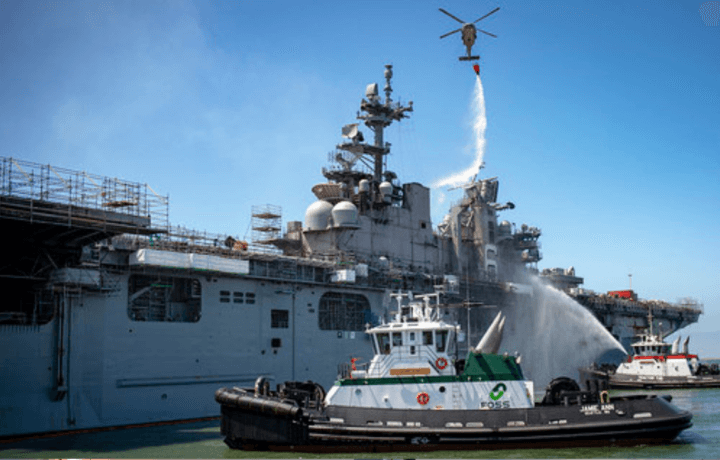The U.S. Navy announced on Monday that it would cut its losses, and decommission and scrap the USS Bonhomme Richard (LHD 6), a Wasp-class amphibious assault ship. The warship suffered extensive damage in July after a fire broke out and raged for more than four days. The vessel is the third U.S. Navy warship to bear the name first given by John Paul Jones to his Continental Navy frigate (French for “Good Man Richard”) during the American Revolution.
“We did not come to this decision lightly,” said Secretary of the Navy Kenneth J. Braithwaite in a statement. “Following an extensive material assessment in which various courses of action were considered and evaluated, we came to the conclusion that it is not fiscally responsible to restore her.
“Although it saddens me that it is not cost effective to bring her back, I know this ship’s legacy will continue to live on through the brave men and women who fought so hard to save her, as well as the Sailors and Marines who served aboard her during her 22-year history,” Braithwaite added.
Too Expensive to Repair
LHD 6 was laid down in April 1995, launched two years later and commissioned in August 1998. The average cost of a Wasp-class LHD ship was originally estimated to be around $750 million. Findings from a Congressional Research Service report in October suggested the cost to replace the vessel with the newer America-class LHA was estimated to be around $4 billion.
However, the Navy estimated that the cost to repair Bonhomme Richard could exceed $3 billion and require five to seven years to complete – and still leave the Navy with a warship that suffered a catastrophic fire.
Neither was a good option, as each would be an unexpected hit on an already taxed shipbuilding budget.
The Navy also reportedly explored rebuilding the ship for an alternative purpose, but it was determined even that could exceed $1 billion, which is as much or even more than the cost of a newly-constructed hospital ship, submarine tender, or command-and-control vessel.
Down a Flattop
The Navy has seven other Wasp-class LHDs in active service, as well as two America-class LHAs including the USS America (LHA-6) and USS Tripoli (LHA-7), the latter of which was commissioned in July. A third, the USS Bougainville, is currently under construction. America-class builder Huntington Ingalls reported in June that the Navy has awarded them a long-lead items procurement contract for the fourth America-class warship.
Both the landing helicopter dock (LHD) and landing helicopter assault (LHA) type of amphibious assault ships are an evolution of aircraft carriers converted for use as helicopter carriers, these also support amphibious landing craft and include a well deck. In addition to being a platform for helicopters, the U.S. Navy’s LHD/LHA warships support vertical short-takeoff and landing fixed-wing aircraft such as the Lockheed Martin F-35C Lightning II.
While the size of the LHD/LHA are actually larger than the aircraft carriers operated by several nations, the United States Navy has relied on these vessels as parts of its efforts to conduct maritime security operations to promote peace and stability in neutral waters around the world. After the USS Theodore Roosevelt (CVN 71) was sidelined due to an outbreak of the novel coronavirus this past spring, USS America was deployed to the South China Sea as a deterrent to Chinese aggression in the region.
This year the Chinese People’s Liberation Army Navy (PLAN) surpassed the U.S. Navy as the largest naval force in the world. Many of its warships are smaller than its American counterparts, but Beijing has also been conducting tests of so-called “carrier killer” hypersonic missiles and other weapons that could shift the balance of power in the western Pacific.
Lessons From the Ashes
The end of the line for a warship is never a happy time, but the fire that devastated Bonhomme Richard could only serve as a warning of the danger of fires on such large vessels. Since July, the U.S. Navy has taken numerous actions that are designed to provide immediate fire safety and prevention improvements across its fleet as well as shore installations.
The fleet commanders have established a Fire Safety Assessment Program to conduct random assessments of ships’ compliance with Navy fire-safety regulations, with a priority on ships undergoing maintenance availabilities. In addition, the Navy announced that Naval Sea Systems Command issued an advisory to all supervising authorities on directed fire prevention requirements and outlined corrective actions to improve fire protection, damage control, and firefighting doctrine, all of which will be executed in close partnerships with industry partners.
The timeline for the towing and eventual dismantlement of the Bonhomme Richard is still being finalized; the Navy has already begun an inactivation availability that will determine how to remove systems and components that can be used on other warships in the fleet.




